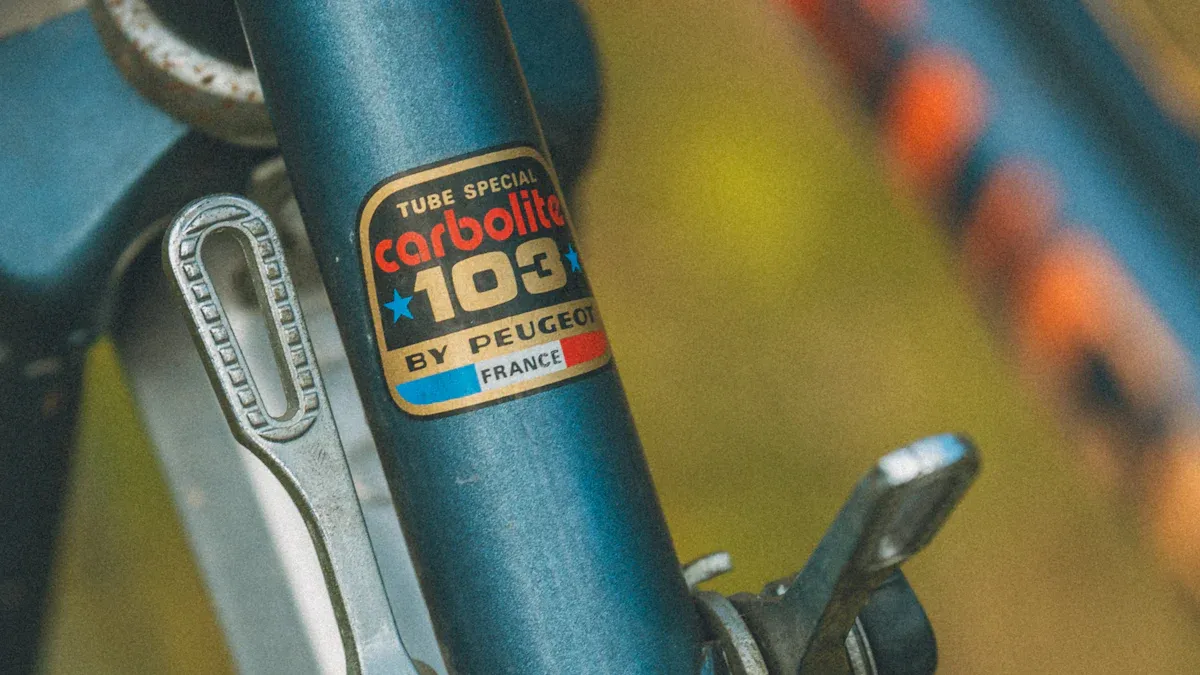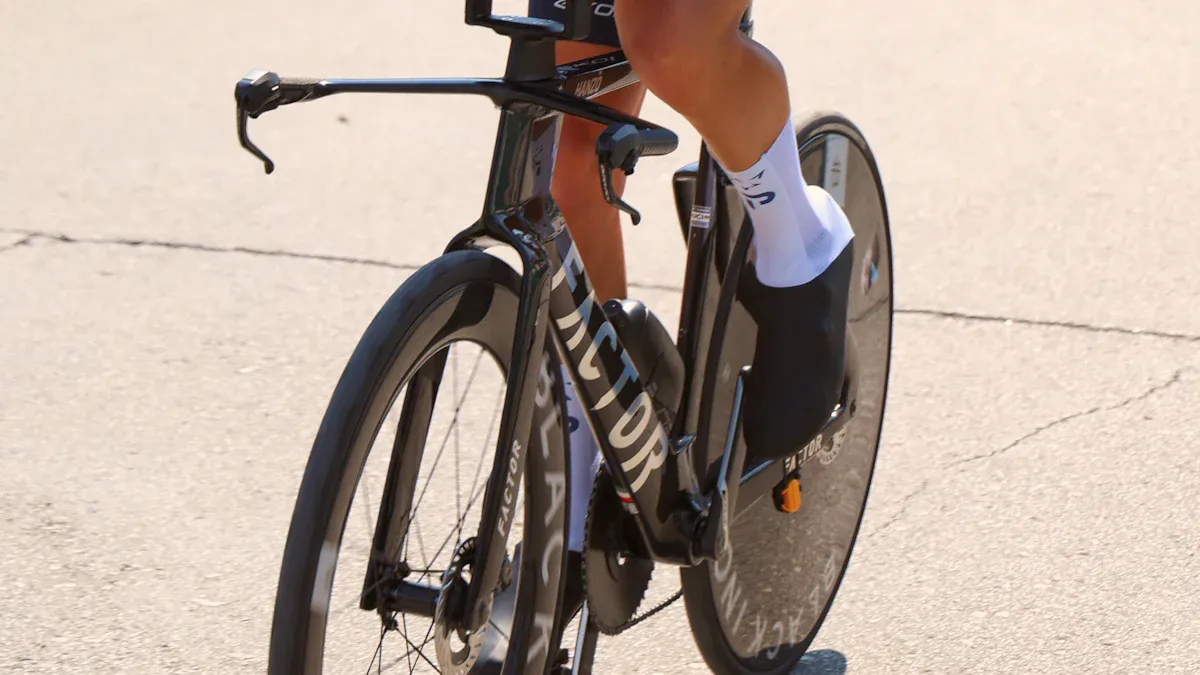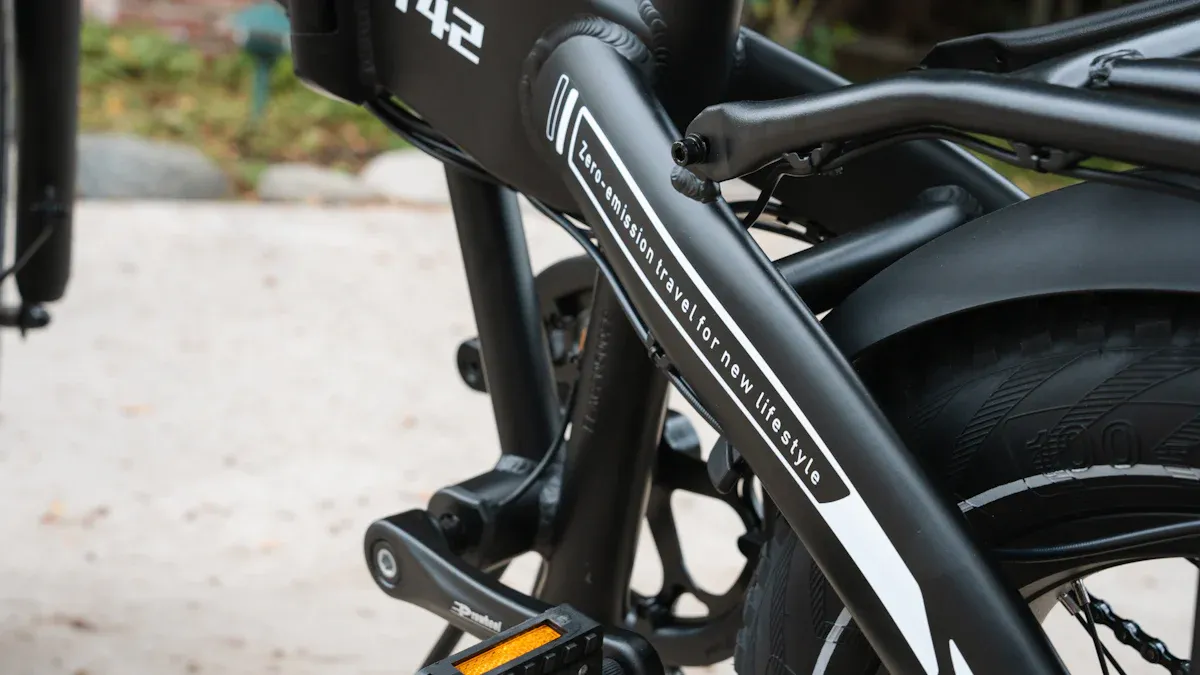
Understanding road bike frame anatomy is very important for improving your cycling performance and comfort. Each part has a big role in how you feel during your ride. For example, research by the VÉLUS group shows that things like frame design and saddle comfort can really change rider satisfaction. Their study found that the right bike parts explained can affect how vibrations impact you on the road. By knowing the anatomy of a bike, you can make smart choices when picking your next bicycle. This will help you have a more enjoyable ride.
Key Takeaways
Knowing about road bike frame parts helps you ride better and feel good.
Picking the right frame material, like aluminum or carbon fiber, changes weight and how the bike feels.
Frame shape, like stack and reach, is important for a comfy fit and good control.
Changing your bike setup can make you more comfortable and improve how you ride; little changes can help a lot.
Checking your bike’s frame often keeps you safe and helps it work well when you ride.
Key Parts of a Road Bike Frame

Knowing the key parts of a road bike frame is important for making your ride better. Each part helps with performance, comfort, and handling. Let’s look at these parts closely.
Top Tube
The top tube links the head tube to the seat tube. It helps resist twisting forces on the bottom tube. This is important for keeping the frame strong while you ride. This part helps the bike stay stiff and resist twisting.
Effective Top Tube Length:
Aspect
Description
Effective Top Tube Length
Measured straight from the top tube/head tube junction to the seat tube, giving a steady measure even with sloping top tubes.
Fitting a road bike right is key for getting power and speed. A lower handlebar position can cut down drag while keeping comfort. Different bike models may feel different even if they are the same size.
Down Tube
The down tube goes from the head tube to the bottom bracket shell. Its size and material greatly affect ride quality. For example, heavier 2OS tubing is about three times stiffer than regular .7/.4/.7 tubing.
Impact of Tube Diameter:
Jan Heine supports better ride quality with thinner traditional-diameter tubing.
A very flexible frame can feel weak for power transfer and harder to control on bumpy roads.
Seat Tube
The seat tube holds the seat post and connects to the bottom bracket shell. The effective seat tube angle (ESTA) is very important in cycling. It affects how your leg muscles work. Changes in ESTA can cause big differences in muscle activity, especially in muscles needed for good pedaling.
Chainstays
Chainstays link the bottom bracket shell to the rear dropouts. They are key for sending power from the pedals to the back wheel.
Key Functions:
Longer chainstays make the bike more stable, especially at high speeds.
They help with pedaling efficiency, making them great for downhill rides.
Bikes with longer chainstays are better for seated climbing. Shorter chainstays are quicker for standing to pedal. This shows how chainstay length affects your riding style and speed during acceleration.
Seatstays
Seatstays connect the top of the seat tube to the rear dropouts. Their shape affects how shock waves travel to the rider. Longer and thinner seatstays allow for better flex, which makes riding more comfortable.
Impact on Comfort and Weight:
Aspect
Impact on Comfort
Impact on Weight
Seatstay Design
Affects shock wave travel to rider
Influences total bike weight
Material Choice
Affects ride quality
Changes weight based on material density
Construction Methods
Affects flex and comfort
Can add or lessen weight
Head Tube
The head tube holds the headset and lets the fork turn. A tapered head tube design makes the bike more stable and strong. This helps with better steering.
Key Features:
A wider base makes it stiffer, leading to smoother and more accurate steering.
More stiffness cuts down flex, allowing for better cornering and handling.
Bottom Bracket
The bottom bracket connects the pedals to the crankset. It helps transfer power from you to the bike.
Importance:
A good bottom bracket helps with power transfer, allowing for faster pedaling without losing energy.
It helps keep the bike stable by providing a strong base for the pedals, which reduces vibrations and improves balance while riding.
Knowing these parts of a road bike frame and how they fit together helps you understand bike anatomy. Each part plays a role in making a strong and efficient bike that improves your cycling performance.
Road Bike Frame Geometry

Knowing road bike frame geometry is very important for getting the best fit and handling on your bike. Geometry means the shape and size of the frame. This greatly affects how you ride. Here are some important measurements and angles to understand.
Stack and Reach
Stack and reach are two key measurements that help you see how well a bike fits you.
Stack measures the height from the bottom bracket to the top of the head tube.
Reach measures the distance from the bottom bracket to the top of the head tube.
These measurements help you compare different bike shapes. A bike with a longer reach may feel stretched out. A bike with a higher stack can give you a more upright position. This is important for comfort and performance, especially on long rides.
Tip: When choosing a bike, think about how stack and reach match your riding style. If you want a more aggressive position for racing, find a bike with a longer reach. For long rides, a higher stack might be more comfy.
Head Tube Angle
The head tube angle affects how your bike steers and handles.
A steeper head tube angle (about 73-75 degrees) gives quicker steering. This helps you turn easily, which is great for racing or tricky courses.
A slacker head tube angle (about 70-72 degrees) makes the bike more stable, especially at high speeds. This design helps avoid sudden turns, making it safer for going downhill.
Here’s how the head tube angle changes your ride:
At low speeds, a steeper angle helps with balance and makes steering easier.
At high speeds, a slacker angle gives better stability, lowering the chance of losing control.
Seat Tube Angle
The seat tube angle affects your position on the bike and how much power you can put out.
A shallower angle (73 to 74 degrees) puts you further back. This can boost your quadriceps and glute strength, which helps when climbing.
A steeper angle (75 to 78 degrees) moves you forward, helping your hamstring strength, which is good for sprinting.
Knowing the seat tube angle helps you find a bike that fits your riding style and boosts your efficiency.
Wheelbase
The wheelbase is the distance between the front and back axles. It is important for balancing stability and how easily you can steer.
A longer wheelbase gives more stability, especially at high speeds. This design is great for long rides where comfort matters.
A shorter wheelbase makes it easier to steer around tight corners. However, it might lose some stability at speed.
Choosing the right wheelbase length is key for your riding experience. A good length for road bikes is about 1 meter, balancing stability and quick response.
Frame Material Considerations
When you pick a road bike, the frame material is very important. Each material has special features that change how the bike performs, its weight, and how comfortable it is. Here’s a look at the most common materials used for bike frames.
Aluminum Frames
Aluminum frames are popular because they are light and cheap. They are very stiff, which helps with power transfer. But over time, they can lose stiffness and are hard to fix if they get damaged.
Pros:
Light and affordable.
Good stiffness for power transfer.
Cons:
Hard to repair.
Can wear out over time.
Carbon Fiber Frames
Carbon fiber frames give great performance and aerodynamics. They are super light and can be customized, making them perfect for racers. However, they are the most costly option and can get damaged easily from hits.
Pros:
Great strength-to-weight ratio.
Light and fast.
Cons:
Costly to repair.
Can be damaged by impacts.
Steel Frames
Steel frames are known for being strong and giving a smooth ride. They are easy to fix, which many cyclists like. But steel frames are usually heavier and can rust if not taken care of.
Pros:
Strong and easy to repair.
Gives a smooth ride.
Cons:
Heavier than other materials.
Can rust.
Titanium Frames
Titanium frames mix strength and lightness, giving a great ride. They are very strong and do not rust, making them last a long time. But titanium frames are very pricey and can be hard to make.
Pros:
Best strength-to-weight ratio.
Very strong and rust-proof.
Cons:
Very expensive.
Hard to repair.
Choosing the right frame material can change your cycling experience a lot. Think about your riding style, budget, and how much you care about performance when picking a bike frame.
Impact of Frame Design on Performance
Aerodynamics
Aerodynamics is very important for how well you cycle. A good bike frame can reduce drag. This helps you ride faster and use less energy. Engineers use special tools like Computational Fluid Dynamics (CFD) to study different frame designs. They look at weight, stiffness, and aerodynamics to find the best mix.
Here’s how different body positions change drag:
Body Position | Drag Reduction Percentage |
|---|---|
Upright | 0% |
Drops | 14% |
Top Bar | 32% |
In the 2024 Tour De France, Tadej Pogačar showed how important aerodynamics is with his Colnago V4Rs bike. This bike helped him stay in a comfy aero position, which helped him win.
Stiffness vs. Comfort
Finding the right mix of stiffness and comfort is key for your ride. Stiffer frames help transfer power better, making your ride feel quicker. But they can also send more road bumps to you, which might be uncomfortable. More flexible frames can soak up shocks from the road, giving you a smoother ride.
The best frame stiffness depends on your weight and riding style. You should think about what feels right for you, as this balance can really affect how well you perform.
Weight Considerations
The weight of your bike frame affects how well you climb and speed up. A lighter bike helps you go faster and climb better. For example, if you and your bike weigh 165 pounds, losing just one pound from the bike can make you climb about 0.6% faster. This small change can save you time on steep hills.
Also, the weight of the wheels matters. Heavier wheels need more energy to speed up. This is important when you need to climb or sprint.
Knowing the parts of a road bike frame can really help your cycling. Here are some important points:
Understanding frame size and fit is key for control and avoiding injuries.
Different materials like aluminum and carbon fiber change weight and how the bike feels, which affects your choice based on how you ride.
The shape of the rear triangle helps with power transfer and stability, making your ride better on bumpy roads.
The type and shape of the fork affect how the bike handles, which is important for picking the right setup for different trails.
You can also improve your current bike setup by learning about frame parts. Try these steps:
Check your current ride to see how your hands feel and how comfortable it is.
Make small changes to the stem height and length that can be easily changed back.
Look at how the bike handles and feels after changes, paying attention to any tingling or discomfort.
Keep testing and adjusting over time to find the best setup.
By using this information, you can choose a bike that works for you and make changes that improve your performance and comfort while riding. Enjoy cycling! 🚴♂️
FAQ
What is the best frame material for beginners?
Aluminum frames are perfect for beginners. They are light, cheap, and strong enough for power transfer. This makes them easy to ride and control.
How does frame geometry affect my riding experience?
Frame geometry affects how you fit and handle the bike. A bike with the right shape helps you stay comfortable and in control, which improves your performance on different surfaces.
Why is bike fit important?
A good bike fit makes riding comfortable and efficient. It helps you avoid injuries and lets you pedal better, making your cycling experience more enjoyable.
Can I change my bike’s frame later?
Yes, you can change your bike’s frame later. But think about the cost and if it will work with your current parts. A new frame can boost performance but might need extra adjustments.
How often should I check my bike’s frame?
You should check your bike’s frame often, especially before long rides. Look for cracks, dents, or wear. Regular checks help keep you safe and ensure good performance.
See Also
Key Factors for Comfort and Speed in Road Bike Frames
The Importance of Frame Size for Comfort and Performance
Simple Techniques to Perfectly Draw Bike Frames
